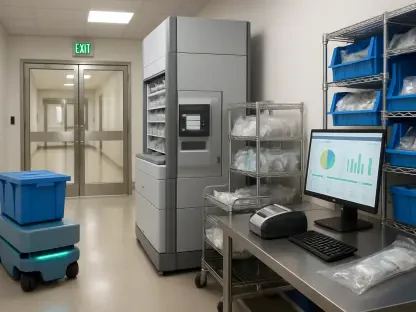Nashoba Valley Medical Center is facing a significant upheaval as its emergency room (ER) is set to close by the end of August. The financial distress of Steward Health Care, the current owner, has led to urgent consideration of alternatives by UMass Memorial Health (UMMH). However, these potential changes have drawn a critical response from the Massachusetts Nurses Association (MNA). Politicians and stakeholders are also voicing concerns about the broader implications for Massachusetts’ healthcare system.
UMass Memorial Health’s Potential Plans for Nashoba
Considering Urgent Care and Skilled Nursing Facilities
UMMH President and CEO Dr. Eric Dickson has proposed converting Nashoba’s ER into an urgent care center or a skilled nursing facility. These alternatives aim to alleviate pressure on other emergency rooms in the region, which are currently overwhelmed. Dr. Dickson believes that a shift to urgent care or skilled nursing could provide necessary relief by redirecting non-critical patients away from already crowded ERs. Despite these considerations, UMMH has emphasized that it has no plans to bid for any Steward-owned hospitals, indicating a more cautious approach, focusing on adaptive reuse rather than outright acquisition.
The proposed conversion has significant implications for community healthcare services. Urgent care centers and skilled nursing facilities offer limited services compared to a full-fledged ER. Community members and healthcare professionals worry about where patients with acute and emergency needs will go once Nashoba’s ER closes. Increased travel times to other facilities could pose significant risks for patients experiencing severe health issues, especially in time-sensitive situations. Moreover, there is a growing apprehension about the potential ripple effect on neighboring hospitals, which could become overwhelmed by the influx of patients that Nashoba would have previously served.
Impact on Community Services
The closure of Nashoba’s ER inevitably raises questions about the adequacy and accessibility of emergency medical services in the local area. An urgent care center provides treatment for non-life-threatening conditions during extended hours, but it lacks the comprehensive emergency services that an ER offers. Similarly, a skilled nursing facility focuses on long-term patient care and rehabilitation but is not equipped to handle emergencies. The transition from a full-service ER to these facilities casts doubt on the community’s capacity to address urgent health issues effectively.
This situation has broader repercussions for regional healthcare. Should Nashoba’s ER close, patients may be forced to seek emergency services further afield, increasing wait times and the likelihood of negative health outcomes. These potential delays are particularly concerning for conditions such as strokes, heart attacks, and severe trauma, where every minute counts. Furthermore, the added pressure on adjacent hospitals could lead to logistical and operational challenges, exacerbating existing strains and possibly degrading the quality of care patients receive. The stakes are high as stakeholders weigh the feasibility of UMMH’s proposals against the critical need for accessible emergency care.
Steward Health Care’s Financial Woes
Background of Bankruptcy and Consequences
Steward Health Care’s financial troubles came to the forefront with its bankruptcy filing in May. This filing has had cascading effects, with the imminent closure of Nashoba’s ER being a direct consequence of the company’s economic distress. Steward has stated that no qualified bids have been made for Nashoba, adding to the uncertainty surrounding the hospital’s future. This development has left the community in a precarious situation, with no clear roadmap for the continuation of essential acute care services. The lack of viable bids highlights the bleak prospects for a straightforward resolution and underscores the hospital’s critical financial vulnerabilities.
The financial instability of Steward Health Care extends beyond Nashoba, raising broader questions about the sustainability of other facilities under its management. It casts doubt on the company’s ability to uphold its operational commitments and maintain consistent, comprehensive healthcare services across its network. As policymakers and health officials grapple with this complexity, the community is left to face the immediate and pressing concern of losing accessible emergency care. The challenges of finding a new operator or a sustainable solution for Nashoba remain daunting, further compounding the distress experienced by patients, staff, and the local population.
Broader Impact on Steward-Managed Facilities
Steward’s financial instability affects more than just Nashoba’s healthcare services. It raises significant concerns about the overall sustainability and operational capacity of other facilities managed by Steward Health Care. These institutions are now faced with a domino effect, as the parent company’s economic struggles threaten to jeopardize continuous and comprehensive healthcare services across the entire network. This instability forces policymakers and health officials to urgently look for ways to safeguard quality care for all residents, while simultaneously navigating the complexities of financial recovery and institutional restructuring.
The uncertainty surrounding these facilities adds another layer of complexity for those responsible for ensuring that high standards of care are maintained. Employees fear job losses, while patients face a future where access to necessary healthcare services could become increasingly limited. As solutions are sought, the broader implications for the Massachusetts healthcare system grow more pronounced. Stakeholders must balance financial recovery efforts with the imperative to provide uninterrupted, quality care, a task that becomes ever more challenging amid the ongoing turmoil affecting Steward-managed institutions. This broader impact signifies the pressing need for a strategic, well-coordinated effort to address and mitigate the crisis.
Opposition from the Massachusetts Nurses Association
Concerns Over Adequate Care
The MNA has expressed strong opposition to UMMH’s plans, arguing that converting the ER into an urgent care center or skilled nursing facility will not meet the needs of Nashoba’s current patient population. They emphasize the necessity of maintaining robust acute care services, which are critical for handling severe health emergencies. The union’s perspective underscores a fundamental concern about the adequacy of the proposed services in addressing the comprehensive needs of patients, especially those requiring immediate and critical medical interventions. This opposition highlights the tension between administrative cost-cutting measures and the frontline realities of patient care.
The MNA’s stance reflects a deep-seated fear that the new facility types will fall short in providing the level of care that an ER can offer. For conditions such as heart attacks, severe injuries, and other life-threatening situations, the specialized services and immediacy provided by an ER are irreplaceable. Urgent care centers and skilled nursing facilities, with their limited scope and capacity, may leave critical gaps in service provision, risking patient health and safety. This viewpoint stresses the importance of prioritizing patient well-being and access to comprehensive emergency services amid the financial and administrative restructuring efforts.
Loss of Psychiatric Services
Another major concern for the MNA is the potential loss of 20 psychiatric beds at Nashoba, which are crucial for treating mentally ill patients. The removal of these vital resources not only impacts Nashoba but compounds the challenges faced by other regional hospitals, which are already struggling to provide sufficient psychiatric care. The loss of psychiatric services is a significant blow to the healthcare infrastructure, especially since mental health care is a critical component of comprehensive healthcare. The MNA fears that eliminating these beds will lead to longer wait times and inadequate care for vulnerable populations in need of specialized mental health services.
This reduction amplifies the strain on an already burdened system, where psychiatric care resources are often limited and overtaxed. Regional hospitals would have to absorb the displaced patient load, potentially leading to overcrowded facilities and longer wait times for psychiatric care. The challenges associated with longer wait times and inadequate treatment are particularly pronounced for mental health patients, who require timely, tailored interventions. The repercussions could include deteriorating mental health conditions and increased strain on emergency services, underscoring the interconnectedness and fragility of healthcare systems. The potential loss of psychiatric beds highlights the necessity of maintaining specialized care capacities within community hospitals.
Political and State-Level Responses
Governor Healey’s Position
Governor Maura T. Healey has publicly condemned Steward Health Care’s mismanagement, acknowledging the crisis but offering few specific solutions for Nashoba. While her administration has earmarked $700 million to support the transition of other Steward-owned hospitals to nonprofit health systems, Nashoba has been notably excluded from this financial aid. This exclusion has drawn attention to the need for targeted interventions that address the unique challenges faced by Nashoba. Without earmarked funds, the path to a sustainable solution for Nashoba remains fraught with uncertainty and complexity.
Governor Healey’s condemnation of Steward’s actions highlights the broader issues of accountability and proper management within the healthcare sector. However, the absence of specific support for Nashoba underscores the difficulties in balancing resource allocation across a strained system. The governor’s stance indicates a recognition of the crisis but also reflects the complexities in addressing it comprehensively. While the substantial financial commitment to other hospitals signifies a proactive approach, Nashoba’s situation remains precarious without similar support. The administration’s efforts reveal the multi-faceted challenges in navigating healthcare transformations within financial constraints.
Call for Proposals and the State’s Role
Governor Healey has stated her openness to any reasonable proposals for Nashoba, yet underscores the lack of serious bidders as a critical barrier. This stance indicates a willingness to explore innovative solutions, but also highlights the difficulties in attracting qualified healthcare providers to take over failing community hospitals. The call for proposals is an invitation for innovative and sustainable solutions that can address Nashoba’s specific needs while recognizing the broader systemic challenges. However, the limited interest reflects the high stakes and inherent risks associated with reviving a financially struggling institution.
The state’s role in mediating and potentially facilitating a viable solution for Nashoba is crucial but complex. Ensuring that any transition aligns with the community’s needs and maintains high standards of healthcare requires a coordinated effort among multiple stakeholders. The shortage of serious contenders willing to step in underscores the broader issues of profitability and sustainability in healthcare, particularly for community hospitals. Governor Healey’s openness to proposals signals a flexible approach, but the path to securing a stable and effective solution remains obstructed by significant hurdles, emphasizing the need for strategic and well-coordinated interventions.
Broader Implications and Systemic Issues
Financial Instability in Community Healthcare
Nashoba’s situation is emblematic of broader financial instability affecting many community hospitals, especially those under private management. The struggle to maintain operations amid financial distress points to systemic issues that require comprehensive solutions beyond individual hospital interventions. The financial challenges facing these hospitals highlight vulnerabilities in the current healthcare system, where the pressures of profitability and cost management often clash with the need to provide accessible, high-quality care. This systemic instability necessitates broader policy discussions and innovative approaches to ensure long-term sustainability and service provision.
The financial woes of Nashoba and other similar institutions call for a re-evaluation of how community hospitals are supported and managed. As private entities like Steward struggle to maintain solvency, the implications for public health are profound. The necessity for a more robust and resilient healthcare infrastructure becomes increasingly evident, with a potential shift towards nonprofit models or greater state intervention as viable solutions. Addressing the underlying financial fragility in the healthcare system is essential to preventing future crises and ensuring that community hospitals can continue to serve their populations effectively and sustainably.
Balancing Efficiency and Comprehensive Care
Nashoba Valley Medical Center is experiencing a major disruption as its emergency room (ER) is scheduled for closure by the end of August. This move stems from the financial difficulties of its current owner, Steward Health Care, prompting urgent evaluations of possible alternatives by UMass Memorial Health (UMMH). These proposed changes have elicited significant criticism from the Massachusetts Nurses Association (MNA), which is deeply concerned about the potential impact on patient care and staff job security. Adding to the chorus of concern are local politicians and various stakeholders who are worried about the broader consequences for the healthcare system in Massachusetts. They argue that the closure of Nashoba Valley’s ER could strain neighboring medical facilities and limit access to critical emergency care for the community. The debate has sparked a wider dialogue on the sustainability of healthcare services in the region, with many calling for comprehensive solutions to ensure that residents continue to receive the medical attention they need.









